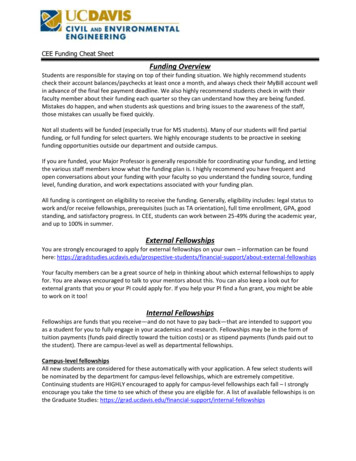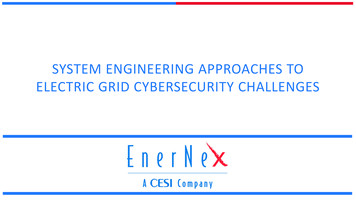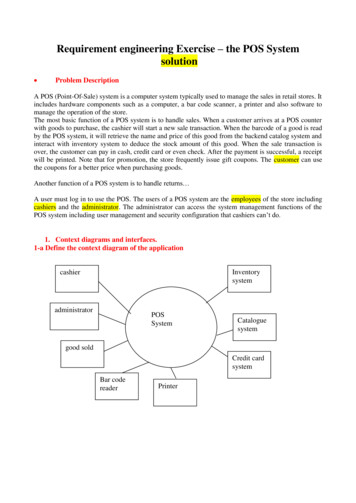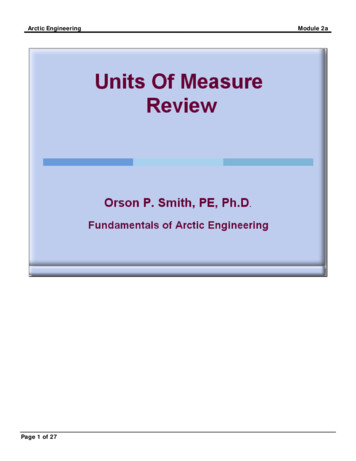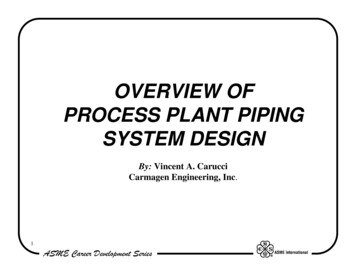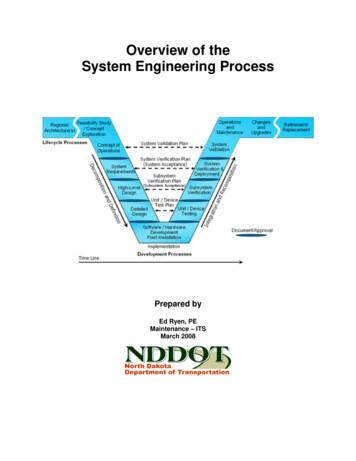
Transcription
Overview of theSystem Engineering ProcessPrepared byEd Ryen, PEMaintenance – ITSMarch 2008
IntroductionThis document provides a high level look at the Systems Engineering Process for ITS projects.More detailed information of the System Engineering process is available through FHWA’spublication, “System Engineering for Intelligent Transportation Systems”. The systemsengineering should be viewed as an extension to the traditional project development process that isalready established in the department. As the NDDOT gains experience with ITS projects and the systemsengineering approach, we will find that we can weave the systems engineering processes and bestpractices into our overall project development process.What is Systems Engineering?Since the term was coined in the 1950s, systems engineering has evolved from a process focusedprimarily on large-scale defense systems to a broader discipline that is used in all kinds of projectdevelopment. Systems engineering can be applied to any system development, so whether you aredeveloping a household appliance, building a house, or implementing a sophisticated transportationmanagement system, systems engineering can be used. INCOSE defines systems engineering like this:Systems Engineering is an interdisciplinary approach and means to enable the realization ofsuccessful systems. It focuses on defining customer needs and required functionality early in thedevelopment cycle, documenting requirements, then proceeding with design synthesis and systemvalidation while considering the complete problem.Systems Engineering integrates all the disciplines and specialty groups into a team effort forminga structured development process that proceeds from concept to production to operation. SystemsEngineering considers both the business and the technical needs of all customers with the goal ofproviding a quality product that meets the user needs.Note that this definition is very broad – it covers the project life cycle from needs definition to systemdisposal. It includes technical activities like requirements and design, as well as project activities like riskmanagement and configuration management. Systems engineering provides a systematic process andtools that directly support project management.What is an ITS Project?In order to apply systems engineering to ITS projects inaccordance with the FHWA Rule/FTA Policy, it is importantto define an ITS project. Rule 940 defines ITS projects quitebroadly:ITS Project means any project that in whole or in partfunds the acquisition of technologies or systems oftechnologies that provide or significantly contributeto the provision of one or more ITS user services asdefined in the National ITS Architecture.This definition encompasses a wide range of projects. SmallerITS projects might be limited to the purchase and installationof field equipment – controllers, environmental sensors,signals, etc. Larger ITS projects support integration ofmultiple systems and development of custom software – forexample, transportation management centers (TMC’s) and511 traveler information systems. These ITS projects are§ 23 CFR 940.11 Project implementation.(a) All ITS projects funded with highwaytrust funds shall be based on a systemsengineering analysis.(b) The analysis should be on a scalecommensurate with the project scope.(c) The systems engineering analysis shallinclude, at a minimum:(1) Identification of portions of the regionalITS architecture being implemented (or if aregional ITS architecture does not exist, theapplicable portions of the National ITSArchitecture);(2) Identification of participating agencies’roles and responsibilities;(3) Requirements definitions;(4) Analysis of alternative systemconfigurations and technology options tomeet requirements;(5) Procurement options;(6) Identification of applicable ITSstandards and testing procedures; and(7) Procedures and resources necessaryfor operations and maintenance
vastly different in complexity and in the amount of systems engineering that is needed. The FHWADivision/FTA Regional Offices establish and monitor how systems engineering analysis requirements arelevied on specific ITS projects.
Systems Engineering PrinciplesStart with Your Eye on the Finish LineYou should reach consensus at the very beginning of the project on what will constitute success at theend. This means that the stakeholders should start with an agreement of what the project shouldaccomplish and the metrics that will be used to measure the success of the project. This initial focus onthe finish line must be sustained by project management as project development progresses andcompeting interests and project complexities begin to dominate the day-to-day work.Stakeholder Involvement is KeySuccessful projects involve the customer, users, operators, and other stakeholders in the projectdevelopment. Systems engineering is a systematic process that includes reviews and decision pointsintended to provide visibility into the process and encourage stakeholder involvement. The systemsengineering process includes stakeholders through all stages of the project, from initial needs definitionthrough system verification and acceptance. The stakeholders who are involved in any particular step willvary, providing managers, operators, and technical personnel with an opportunity to contribute to thesteps in the process where their input is needed.The “V” Systems Engineering ModelMany different process models have been developed over the years that specify a series of steps that makeup the systems engineering approach6. Among these models, the “V” model, shown in Figure 7, ismerging as the de facto standard way to represent systems engineering for ITS projects. Don’t besurprised if you come across different spellings for the “V” model. Some books, guides, and otherresources refer to the same V-shaped model as the “Vee” model. If it looks like a “V” and it sounds like a“V”, then it is a reference to the same basic model, whether it is spelled “V” or “Vee”.Since it was first developed in the 1980s, the “V” model has been refined and applied in many differentindustries. Wings have been recently added to the “V” as part of its adaptation for ITS to show howproject development fits within the broader ITS project life cycle. The left wing shows the regional ITSarchitecture, feasibility studies, and concept exploration that support initial identification and scoping ofan ITS project based on regional needs. A gap follows the regional architecture(s) step because theregional architecture is a broader product of the planning process that covers all ITS projects in theregion. The following steps in the “V” are for a specific ITS project. The central core of the “V” showsthe project definition, implementation, and verification processes. The right wing shows the operationsand maintenance, changes and upgrades, and ultimate retirement of the system. The wings are a keyaddition to the model since it is important to consider the entire life cycle during project development.
What are the Parts of the “V” DiagramUsing the Regional ITS ArchitectureIn this step: The portion of the regional ITS architecturethat is related to the project is identified. Other artifacts of theplanning and programming processes that are relevant to theproject are collected and used as a starting point for projectdevelopment. This is the first step in defining your ITS project.OBJECTIVES Define the project scope while considering the regional vision and opportunities for integration Improve consistency between ITS projects and identify more efficient incrementalimplementation strategies Improve continuity between planning and project developmentINPUTSources of Information Relevant regional ITS architecture(s) Regional/national resources supporting architecture use Other planning/programming products relevant to the projectPROCESSKey Activities Identify regional ITS architecture(s) that are relevant to the project Identify the portion of the regional ITS architecture that applies Verify project consistency with the regional ITS architecture and identify any necessarychanges to the regional ITS architectureOUTPUTProcess Results List of project stakeholders and roles and responsibilities List of inventory elements included in or affected by the project List of requirements the proposed system(s) must meet List of interfaces and the information to be exchanged or shared by the system(s) Regional ITS architecture feedback as necessaryREVIEWProceed only if you have: Demonstrated consistency with the regional ITS architecture and identified needed changes tothe regional ITS architecture, if applicable Extracted the relevant portion of the regional ITS architecture that can be used in subsequentsteps Reached consensus on the project/system scope
OverviewThe regional ITS architecture provides a good starting point for systems engineering analyses that areperformed during ITS project development. It provides region-level information that can be used andexpanded in project development. When an ITS project is initiated, there is a natural tendency to focus onthe programmatic and technical details and to lose sight of the broader regional context. Using theregional ITS architecture as a basis for project implementation provides this regional. It provides eachproject sponsor with the opportunity to view their project in the context of surrounding systems. It alsoprompts the sponsor to think about how the project fits within the overall transportation vision for theregion. Finally, it identifies the integration opportunities that should be considered and provides a headstart for the systems engineering analysis.Example: NDDOT Architecture Subset; Weather Data
Feasibility Study/Concept ExplorationIn this step: A business case is made for the project.Technical, economic, and political feasibility is assessed;benefits and costs are estimated; and key risks areidentified. Alternative concepts for meeting the project’spurpose and need are explored, and the superior concept isselected and justified using trade study techniques.OBJECTIVES Identify superior, cost-effective concept, and document alternative concepts with rationale forselection Verify project feasibility and identify preliminary risks Garner management buy-in and necessary approvals for the projectINPUTSources of Information Project goals and objectives Project purpose and need Project scope/subset of the regional ITS architecturePROCESSKey Activities Define evaluation criteria Perform initial risk analysis Identify alternative concepts Evaluate alternatives Document resultsOUTPUTProcess Results Feasibility study that identifies alternative concepts and makes the business case for the projectand the selected conceptREVIEWProceed only if you have: Received approval on the feasibility study from project management, executive management,and controlling authorities, as required Reached consensus on the selected alternativeOverviewIn this step, the proposed ITS project is assessed to determine whether it is technically, economically, andoperationally viable. Major concept alternatives are considered, and the most viable option is selected andjustified. While the concept exploration should be at a fairly high level at this early stage, enoughtechnical detail must be included to show that the proposed concept is workable and realistic. Thefeasibility study provides a basis for understanding and agreement among project decision makers –project management, executive management, and any external agencies that must support the project,such as a regional planning commission.
Concept of OperationsIn this step: The project stakeholders reach a sharedunderstanding of the system to be developed and how it will beoperated and maintained. The Concept of Operations(ConOps) is documented to provide a foundation for moredetailed analyses that will follow. It will be the basis for thesystem requirements that are developed in the next step.OBJECTIVES High-level identification of user needs and system capabilities in terms that all projectstakeholders can understand Stakeholder agreement on interrelationships and roles and responsibilities for the system Shared understanding by system owners, operators, maintainers, and developers on the who,what, why, where, and how of the system Agreement on key performance measures and a basic plan for how the system will be validatedat the end of project developmentINPUTSources of Information Stakeholder lists, roles and responsibilities, and other components from the regional ITSarchitecture Recommended concept and feasibility study from the previous step Broad stakeholder input and reviewPROCESSKey Activities Identify the stakeholders associated with the system/project Define the core group responsible for creating the Concept of Operations Develop an initial Concept of Operations, review with broader group of stakeholders, anditerate Define stakeholder needs Create a System Validation PlanOUTPUTProcess Results Concept of Operations describing the who, what, why, where, and how of the project/system,including stakeholder needs and constraints System Validation Plan defining the approach that will be used to validate the project deliveryREVIEWProceed only if you have: Received approval on the Concept of Operations from each stakeholder organization Received approval on the System Validation Plan from each stakeholder organization
OverviewThe Concept of Operations (ConOps) is a foundation document that frames the overall system and setsthe technical course for the project. Its purpose is to clearly convey a high-level view of the system to bedeveloped that each stakeholder can understand. A good ConOps answers who, what, where, when, why,and how questions about the project from the viewpoint of each stakeholder. Who – Who are the stakeholders involved with the system? What – What are the elements and the high-level capabilities of the system? Where – What is the geographic and physical extent of the system? When – What is the sequence of activities that will be performed? Why – What is the problem or opportunity addressed by the system? How – How will the system be developed, operated, and maintained?
System RequirementsIn this step: The stakeholder needs identified in the Concept ofOperations are reviewed, analyzed, and transformed into verifiablerequirements that define what the system will do but not how thesystem will do it. Working closely with stakeholders, therequirements are elicited, analyzed, validated, documented, andbaselined.OBJECTIVES Develop a validated set of system requirements that meet the stakeholders’ needsINPUTSources of Information Concept of Operations (stakeholder needs) Functional requirements, interfaces, and applicable ITS standards from the regional ITSarchitecture Applicable statutes, regulations, and policies Constraints (required legacy system interfaces, hardware/software platform, etc.)PROCESSKey Activities Elicit requirements Analyze requirements Document requirements Validate requirements Manage requirements Create a System Verification Plan Create a System Acceptance PlanOUTPUTProcess Results System Requirements document System Verification Plan Traceability Matrix System Acceptance PlanREVIEWProceed only if you have: Received approval on the System Requirements document from each stakeholder organization,including those that will deploy, test, install, operate, and maintain the new system Received approval on the System Verification Plan from the project sponsor, the test team, andother stakeholder organizations Received approval on the System Acceptance Plan from the project sponsor, the Operations &Maintenance (O&M) team, and other stakeholder organizationsOverviewOne of the most important attributes of a successful project is a clear statement of requirements that meetthe stakeholders’ needs. Unfortunately, creating a clear statement of requirements is often much easiersaid than done. The initial list of stakeholder needs that are collected will normally be a jumble of
requirements, wish lists, technology preferences, and other disconnected thoughts and ideas. A lot ofanalysis must be performed to develop a good set of requirements from this initial list.
System DesignIn this step: A system design is created based on thesystem requirements including a high-level design thatdefines the overall framework for the system. Subsystemsof the system are identified and decomposed further intocomponents. Requirements are allocated to the systemcomponents, and interfaces are specified in detail.Detailed specifications are created for the hardware andsoftware components to be developed, and final productselections are made for off-the-shelf components.OBJECTIVES Produce a high-level design that meets the system requirements and defines key interfaces, and thatfacilitates development, integration, and future maintenance and upgrades Develop detailed design specifications that support hardware and software development andprocurement of off-the-shelf equipmentINPUTSources of Information Concept of Operations System Requirements document Off-the-shelf products Existing system design documentation ITS standards Other industry standardsPROCESSKey Activities Evaluate off-the-shelf components Develop and evaluate alternative high-level designs Analyze and allocate requirements Document interfaces and identify standards Create Integration Plan, Subsystem Verification Plans, and Subsystem Acceptance Plans Develop detailed component-level design specificationsOUTPUTProcess Results Off-the-shelf evaluation and alternatives summary reports High-level (architectural) design Detailed design specifications for hardware/software Integration Plans, Subsystem Verification Plans, Subsystem Acceptance Plans, andUnit/Device Test PlansREVIEWProceed only if you have: Approved high-level design for the project Defined all system interfaces Traced the system design specifications to the requirements Approved detailed specifications for all hardware/software components
OverviewIn the systems engineering approach, we define the problem before we define the solution. The previoussteps in the “V” have all focused primarily on defining the problem to be solved. The system design stepis the first step where we focus on the solution. This is an important transitional step that links the systemrequirements that were defined in the previous step with system implementation that will be performed inthe next step. There are two levels of design that should be included in your project design activities;High-level design and Detail design.
Software/Hardware Development and TestingIn this step: Hardware and software solutions arecreated for the components identified in the systemdesign. Part of the solution may require custom hardwareand/or software development, and part may beimplemented with off-the-shelf items, modified asneeded to meet the design specifications. Thecomponents are tested and delivered ready forintegration and installation.OBJECTIVES Develop and/or purchase hardware and software components that meet the designspecifications and requirements with minimum defects Identify any exceptions to the requirements or design specifications that are requiredINPUTSources of Information System and subsystem requirements System design Off-the-shelf products Industry standards Unit/Device Test PlansPROCESSKey Activities Plan software/hardware development Establish development environment Procure off-the-shelf products Develop software and hardware Perform unit/device testingOUTPUTProcess Results Software/hardware development plans Hardware and software components, tested and ready for integration Supporting documentation (e.g., training materials, user manuals, maintenance manuals,inst
Overview of the System Engineering Process Prepared by Ed Ryen, PE . multiple systems and development of custom software – for example, transportation management centers (TMC’s) and 5


